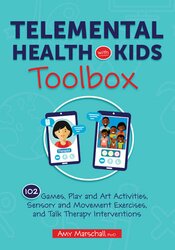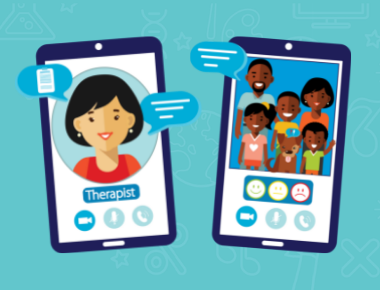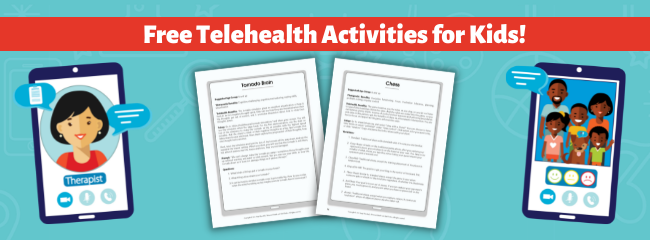5 Tips for Telehealth with Kids
Strategies for success, plus 2 free worksheets

Therapists are still reeling from the impact that the COVID-19 pandemic had on therapy. While sessions continued with telehealth options, gone was the safe space of a shared room with our clients. And though all mental health providers faced challenges with providing a new kind of care, those of us working with children faced additional trials. Holding a young client’s focus on a digital platform, one that did not allow us to follow them if they moved around the space, required therapists to completely rethink play therapy and kid-friendly interventions.
What can you do to keep your clients engaged in telehealth sessions? The following five tips are essential to boosting your practice in a world of online therapy.
1. Be Honest About the Experience
2. Be Flexible With Your Interventions
3. Get Creative
4. Make Technical Issues Therapeutic
5. Have an Arsenal of Interventions
Having your sessions online doesn’t have to upend your entire process when working with young clients. Although telehealth adds challenges to therapy with kids, it also creates opportunities for innovation, flexibility, and connecting with your clients. After transitioning your clients online and adding some new interventions to your repertoire, you can reinvent your therapy process—wherever it may be!
Check out two of my favorite telemental health interventions here – completely free!
Want more kid-friendly resources? Discover new strategies to keep children and teens engaged in online. Check out Zoom Fatigue, It's Real
What can you do to keep your clients engaged in telehealth sessions? The following five tips are essential to boosting your practice in a world of online therapy.
1. Be Honest About the Experience
- Although telehealth sessions will follow the same general outline and as any “normal” in-person session, the change will be an adjustment for the therapist and the client.
Make a point to reassure your clients that you are there for them and that they can still have sessions, but tell them honestly that you will be “learning together” as you transition to telehealth. Be realistic about challenges you might face and open with your own emotions about the situation.
Because of your own transparency, clients will feel more comfortable sharing their questions and concerns with you, and you can use the opportunity to model communication and regulation skills.
2. Be Flexible With Your Interventions
- If you use a non-directive therapeutic approach, you are used to giving your young clients some level of control over their sessions. This helps clients engage because they have a say in the activities.
Ask children what they want their session to look like, what they wish they could do in therapy, or which games or activities they enjoy. Then, see how you can incorporate that into your sessions. You may find brand new activities that you can share across clients!
As a child therapist, your goal should not be to force a specific intervention, but to make whatever happens organically in the session therapeutic. You can pull treatment goals into a myriad of games and activities.
3. Get Creative
- Creativity is one of the most important aspects of child therapy, as every young client learns, develops, and copes differently. At first, telehealth sessions can feel limiting because you and your clients are not sharing physical space, but if you think about it, the Internet actually expands your options!
What kinds of activities does your client enjoy doing on their tablet, phone, or laptop? How can you make those activities therapeutic? What skills does the child need to play those games, and how can those skills tie into their treatment goals?
Do not be afraid to try something new in a session or experiment with interventions you have not tried before. The possibilities in a telehealth session are endless!
4. Make Technical Issues Therapeutic
- Technical issues can be the most frustrating part of telehealth sessions. Dropped calls, audio or video problems, and low bandwidth interfere with our sessions at any time and are incredibly annoying for you and your clients.
However, technical issues offer yet another opportunity for intervention! When faced with an issue, a client must engage in problem-solving during their session. In real time, the client might have to ask an adult for help, try different things to find a solution, or cope with feelings of frustration, annoyance, or anger.
When technical difficulties arise in a session, you can see it as an intervention and pull for these skills, making the moment therapeutic. You also get to show your clients that you are going to stick with them and work through challenges together.
5. Have an Arsenal of Interventions
- Although your clients can provide great ideas for their sessions, it is your job as therapist to guide them and to introduce things that will help them move toward their treatment goals.
Even when children are unsure about what they want to do in session, they can be picky about the activities you suggest. When a child lets you choose a game, give them a couple of options rather than simply picking something. It is helpful to have several activities on deck to suggest if a child does not take to your first idea or needs to practice a specific skill.
I use keywords and therapy skills to label my various telehealth interventions. This helps me decide which choices are the best fit for the client and streamlines writing my notes.
Having your sessions online doesn’t have to upend your entire process when working with young clients. Although telehealth adds challenges to therapy with kids, it also creates opportunities for innovation, flexibility, and connecting with your clients. After transitioning your clients online and adding some new interventions to your repertoire, you can reinvent your therapy process—wherever it may be!
Check out two of my favorite telemental health interventions here – completely free!
Want more kid-friendly resources? Discover new strategies to keep children and teens engaged in online. Check out Zoom Fatigue, It's Real
Discover 102 Games, Play and Art Activities, Sensory and Movement Exercises, and Talk Therapy Interventions

Keeping kids engaged in therapy comes with its own set of challenges – and doing it over a screen is no exception.
As clinicians increasingly make the switch to remote therapy, the need for kid-friendly telehealth interventions has become more crucial than ever. In Telemental Health with Kids Toolbox, Dr. Amy Marschall has created an arsenal of flexible, creative, and fun virtual interventions that will allow you to provide effective, evidence-based treatment while still capturing the attention of even the youngest of clients. Inside you’ll find over 100 ready-to-use telehealth games, exercises, and activities that offer the same therapeutic benefits as your in-person sessions. Each intervention includes suggested age ranges and step-by-step instructions, equipping you with the tools you need to effectively (and confidently!) provide treatment through a screen. You’ll also receive guidance on how to create your own kid-friendly, virtual intervention that are unique to your practice!
As clinicians increasingly make the switch to remote therapy, the need for kid-friendly telehealth interventions has become more crucial than ever. In Telemental Health with Kids Toolbox, Dr. Amy Marschall has created an arsenal of flexible, creative, and fun virtual interventions that will allow you to provide effective, evidence-based treatment while still capturing the attention of even the youngest of clients. Inside you’ll find over 100 ready-to-use telehealth games, exercises, and activities that offer the same therapeutic benefits as your in-person sessions. Each intervention includes suggested age ranges and step-by-step instructions, equipping you with the tools you need to effectively (and confidently!) provide treatment through a screen. You’ll also receive guidance on how to create your own kid-friendly, virtual intervention that are unique to your practice!
Meet the Expert:
Amy Marschall, PsyD, is a licensed clinical psychologist in South Dakota. Dr. Marschall works primarily with children and adolescents, adopting a telemental health strategies early into her clinical practices, and is a Certified Clinical Telemental Health Provider (CTMH) and is certified in Trauma-Focused Cognitive Behavioral (TF-CBT). In 2016, Dr. Marschall helped develop a telemental health task force at Sioux Falls Psychological Services to develop an ethical and effective model to provide telehealth services to individuals living in rural South Dakota without access to mental health resources. Dr. Marschall co-developed and presented a six-hour seminar on ethical and legal guidelines for telemental health in 2017 and has been providing these services in South Dakota since this time.
Learn more about their educational products, including upcoming live seminars, by clicking here.
Learn more about their educational products, including upcoming live seminars, by clicking here.




